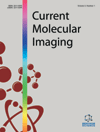- Home
- A-Z Publications
- Current Molecular Imaging (Discontinued)
- Previous Issues
- Volume 2, Issue 1, 2013
Current Molecular Imaging (Discontinued) - Volume 2, Issue 1, 2013
Volume 2, Issue 1, 2013
-
-
Fluorescence Imaging in Cancerology
More LessFluorescence imaging is nowadays a powerful tool for laboratory animal studies in oncology. This emerging technology is in full development and is becoming a complementary tool in clinics for specific cancer diagnosis. For now, it allows detection with a high spatio-temporal resolution of specific signals like tumor markers in small animals. Different ways of in vivo imaging exist: epifluorescence macroscopy, intravital imagi Read More
-
-
-
Bioluminescence Imaging in Rodents: When Light Illuminates Cancer Research
More LessAuthors: Stephanie Lerondel and Alain Le PapeAmong all the preclinical imaging modalities available for scientifist to explore animal models, especially rodents, bioluminescence imaging (BLI), fluorescence and photoacoustic imaging strategies are the only ones that are not derived from medical imaging. Based on a chemical reaction involving an enzyme and its substrate to convert chemical energy into light emission, BLI is relatively recent (˜ 15 years). However, it is r Read More
-
-
-
Perfusion Computed Tomography and its Application in Oncologic Practice
More LessAuthors: Rosalind Mitchell Hay, Sofia Gourtsoyianni and Vicky GohPerfusion computed tomography (CT) is an imaging technique that enables radiologists to evaluate the tumour vasculature, quantifying tumour perfusion, blood volume, and microcirculatory changes, which can provide both prognostic and predictive information to the clinician. Its increasing acceptance within oncology in recent years has been related to a combination of factors: an increasing use of anti-vascular therapy (ant Read More
-
-
-
The Role of PET/CT and SPECT/CT in Oncology Drug Development
More LessAuthors: Karen A Kurdziel, Liza Lindenberg, Esther Mena, Baris Turkbey and Peter ChoykeUnderstanding the hallmarks of cancer is valuable in advancing drug development to fight the disease. With the advent of molecular imaging, non-invasive in vivo visualization of physiology and functional pathways allow for multiple levels of disease and therapy assessment beyond tumor size measurements offered by conventional anatomic scans. Radiolabeling targeted molecules can provide insight into tumor interactions wi Read More
-
-
-
State-of-the-Art Magnetic Resonance Spectroscopy in Oncologic Imaging
More LessMagnetic resonance (MR) is often the modality of choice to image cancer patients. In standard-of-care clinical practice magnetic resonance imaging (MRI) is commonly used to obtain anatomical information based on physical properties of tissue water, but MR techniques are very versatile and can also be applied for functional and metabolic assessment. Metabolic aberrations are common in cancers either as a dir Read More
-
-
-
PET-MRI Based Molecular Imaging as a Response Marker in Cervical Cancer: A Systematic Review
More LessTherapeutic strategies continue to evolve for treatment of women with cervical cancer. However there is dearth of validated biomarkers of therapeutic response and overall survival. In recent years development of molecular imaging techniques using Magnetic Resonance Imaging (MRI) and Positron Emission Tomography (PET) has allowed evaluation of imaging biomarkers of proliferation, angiogenesis, perfusion and hyp Read More
-
-
-
Ultrasound Contrast Imaging in Cancer –Technical Aspects and Prospects
More LessAuthors: Anthony Novell, Jean-Michel Escoffre and Ayache BouakazUltrasound imaging is still an attractive imaging modality thanks to its real-time character and low-cost. Recent technological developments in ultrasound imaging improved significantly the accuracy and confidence of clinical diagnoses. The clinical availability of ultrasound contrast agents over the past 20 years was one of the main recent developments in ultrasound imaging since contrast agents showed a major interest i Read More
-
-
-
Photoacoustic Imaging for Cancer Detection and Staging
More LessAuthors: Mohammad Mehrmohammadi, Soon Joon Yoon, Douglas Yeager and Stanislav Y. EmelianovCancer is one of the leading causes of death in the world. Diagnosing a cancer at its early stages of development can decrease the mortality rate significantly and reduce healthcare costs. Over the past two decades, photoacoustic imaging has seen steady growth and has demonstrated notable capabilities to detect cancerous cells and stage cancer. Furthermore, photoacoustic imaging combined with ultrasound imaging Read More
-
Volumes & issues
Most Read This Month
Article
content/journals/cmi
Journal
10
5
false
en


